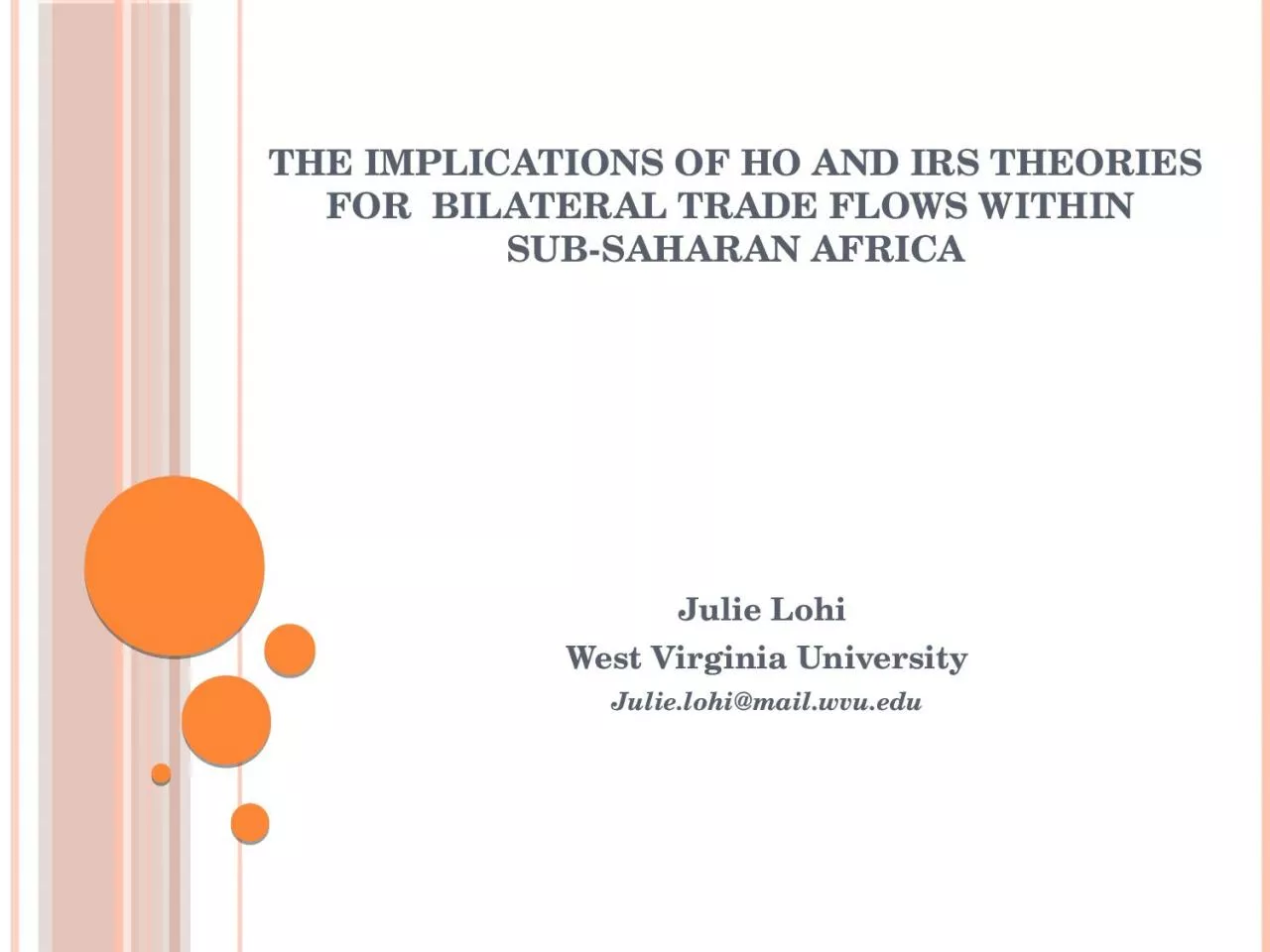

SubSaharan Africa Julie Lohi West Virginia University Julielohimailwvuedu Motivation Why Bilateral trade Flows are Low within SubSaharan Africa SSA Literature Hanink and Owusu ID: 915680
Download Presentation The PPT/PDF document "The Implications of HO and IRS Theories ..." is the property of its rightful owner. Permission is granted to download and print the materials on this web site for personal, non-commercial use only, and to display it on your personal computer provided you do not modify the materials and that you retain all copyright notices contained in the materials. By downloading content from our website, you accept the terms of this agreement.
Slide1
The Implications of HO and IRS Theories for Bilateral Trade Flows within Sub-Saharan Africa
Julie
Lohi
West Virginia
University
Julie.lohi@mail.wvu.edu
Slide2MotivationWhy Bilateral trade Flows are Low within Sub-Saharan Africa (SSA)?
Slide3LiteratureHanink and Owusu
(1998)
Used trade intensity index (TII)
Find
that ECOWAS has failed to promote
trade
Alemayehu
and Haile (2008)
Regional grouping has insignificant effects on bilateral trade flows in SSA.
Reasons: poor private participation, compensation issue
.
Faezeh
and Pritchett (2009)
Trade flows are low within SSA
Gravity prediction similar to actual trade
Piet and Wheeler (2010)
T
ransport
infrastructure and border restrictions are main reasons for lower trade rate in SSA
Slide4ContributionsTrade evaluation based on imperfect specialization in productionShow that comparative advantages matter in stimulating trade
SSA countries exhibit similar endowments
Products are not differentiated in the region
Slide5Underlying trade TheoriesHeckscher-Ohlin Theory: Heckscher (1919) and Ohlin (1933
)
Predicts
high trade for large differences in factor endowment
ratios.
Increasing return to scale theory:
Krugman
(1979, 1980)
Predicts intensive trade between industries producing different varieties of a product.
The love of varieties creates demand across countries.
Slide6Methodologies
A-
Build on
Evenett
and Keller (2002) to estimate the gravity equation for 118 countries grouped into 5 regions
Where
,
,
are respectively imports of country
i
from country j, GDP of country i, j, world and region; is importing country’s specifics;represent respective dummies for common language, colony, contiguity, and landlocked; is the log of distance between country i and j.
Slide7Methodologies
B-
Compute
the
Grubel
Lloyd
index as:
,
,
where,
represents a
commodity
,
the
Grubel
Lloyd index reflects the intra industrial trade (imports and exports) of country from (to) country. export value from country to country in differentiated goods imports value in good of country from
Slide8Methodologies
C-
Assess capital (
) to labor (
) ratio difference within each region
Compute
for each country and the difference between each pair of countries
Slide9Data
118 countries across the world grouped into 5 regions:
Asia, Europe and North America, Latin America and Caribbean, Middle East and North Africa, and Sub-Saharan Africa.
Panel from 1997 to
2007
Data on bilateral imports is extracted from the
IMF-DOT
Data on Real GDP, Investment Share, Real GDP per worker, and population are taken from the Penn World Tables (last version- 6.3
)
Data on trade
factor dummies can be found at
http
://www.cepii.fr/anglaisgraph/bdd/distances.htm
Capital stock and labor force data are from the World Bank’s World Development indicator (WDI) databaseThe Grubel Llyod is calculated using Uncomtrade data at 3-digit.
Slide10Results
Slide11Results
Slide12Results
Slide13Results
Slide14Concluding remarksBilateral trade flows are low within SSA compare to that of other regions due to:
Lack of comparative advantage in production across countries in
SSA
S
imilar endowments in factors of production across countries within SSA
Homogeneity of traded goods
Less product differentiation
Slide15Suggestions
SSA countries might want to increase efforts towards
accessing developed markets
Gain the “know-how”
from interacting with mature markets
B
enefit
from
their
comparative advantage over industrialized
countries
Use new technologies for industrialization and differentiate their products in many varieties.
Slide16Thank you for your attention
Your comments are very welcome!